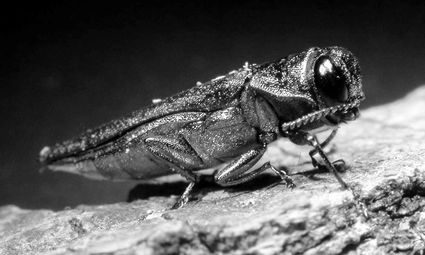Emerald Ash Borer – A Future Threat to Local Forest Industry?
Oswego County, NY -- Salmon River Steward Greg Chapman is educating the public he encounters along the Salmon River corridor about emerald ash borer, a species of invasive insect that could threaten New York forests.
“The arrival of the shiny, emerald green beetle, about ½ inch long and 1/8 inch wide, in the U.S. in southeastern Michigan in 2002 may be as serious a threat to white, green, and black ash trees as Dutch elm disease was to the American elm,” Chapman says.
Ash trees are a common species in the Salmon River corridor and surrounding area, and comprise as much as 20 percent of our region’s forests, Chapman says. Green and black ash grow in wet swampy areas and along streams and rivers; white ash is common in drier, upland soils.
“Many species of wildlife, including some waterfowl and game birds, feed on ash seeds. Ash is used as a source for hardwood timber, firewood, and for the manufacturing of baseball bats and hockey sticks. The New York State Department of Agriculture and Markets estimates the total economic value of New York’s white ash to be $1.9 billion dollars,” Chapman says.
“Although the emerald ash borer has not yet been found in the forests of the Salmon River corridor or anywhere in New York, infestations in Pennsylvania, Ontario and Quebec have the potential of slowly spreading to our area through natural range expansion. Emerald ash borer could arrive here more quickly on transported firewood or lumber,” Chapman says.
Emerald ash borer larva hatch and burrow deep into the sapwood of healthy ash trees where they aggressively feed until autumn, destroying essential conductive tissue. The larva overwinter in the tree, emerging as adults from May through July of the next year, leaving distinct, D-shaped emergence holes about 3 mm in diameter. Adults mate soon after emergence, and lay eggs under the bark of nearby ash trees. Eggs hatch within seven to nine days in the late spring or early summer, starting the destructive cycle once more.
Surveying, Regulations and Research to Prevent Spread
The emerald ash borer was most likely introduced into North America via wood and packing materials imported from its native range in China and eastern Asia. Since its initial discovery, infestations have been found in Indiana, Illinois, Maryland, Michigan, Ohio, West Virginia, Wisconsin, Missouri and Pennsylvania, as well as Ontario and Quebec. To date, the invasive pest is thought to be responsible for the deaths of millions of ash trees according to the United States Department of Agriculture (USDA).
Area foresters, landowners and New York State Department of Environmental Conservation (NYSDEC) officials consider the threat from emerald ash borer to be real. Extensive surveying is taking place in high-risk areas, including the nearby St. Lawrence River corridor. NYSDEC recently enacted regulations prohibiting the movement of firewood more than 50 miles from its source to prevent or slow the spread of destructive forest insects and pathogens. Campers are encouraged to “burn it (firewood) where you buy it.”
Universities and state and federal agencies, including the USDA Animal and Plant Health Information Service and the USDA Forest Service, are undertaking research to halt the spread or minimize the effects of emerald ash borer. Biologists are testing chemical control agents and searching the beetle’s native range for biological controls such as parasites that prey on the beetles’ larva.
If You See Emerald Ash Borer
Chapman encourages those who frequent the forested areas along the Salmon River from the Redfield reservoir to Port Ontario to be on the lookout for metallic green beetles. They may or may not be emerald ash borers. Other insects similar in appearance to emerald ash borer may be found locally. These insects along with pathogens, and environmental stresses may adversely affect the health of ash trees.
“If you suspect an insect is emerald ash borer, try confirming your suspicions using photos and information online the websites of the New York State Department of Environmental Conservation at http://www.dec.ny.gov, or at http://www.EmeraldAshBorer.info,” Chapman advises. “If you believe the insect you have seen may indeed by emerald ash borer, please report your sighting to Christopher Lajewski, The Nature Conservancy, 315-387-3600 x22.”
The Salmon River Steward Program is managed by New York Sea Grant in partnership with the New York State Department of Environmental Conservation, and The Nature Conservancy.
Caption: The emerald ash borer, a shiny green beetle, is an invasive pest that threatens to arrive in New York forests. Photo: David Cappaert, Michigan State University







Reader Comments(0)